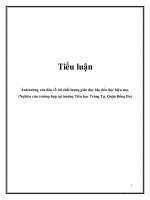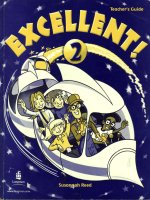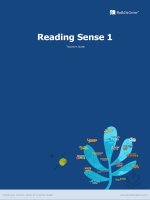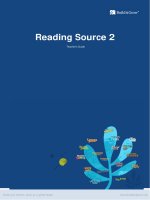Read and retell 2 Teachers Guide
Bạn đang xem bản rút gọn của tài liệu. Xem và tải ngay bản đầy đủ của tài liệu tại đây (7.98 MB, 157 trang )
Unit 1| Grandpa’s Hobby
Read & Retell 2: Teacher’s Guide
Read & Retell Objectives:
1. Retelling is the best after reading activity for young learners to summarize what they have read. Retelling helps
readers create a mental image of the story. Also, retelling allows teachers to assess learners’ comprehension as well as
oral fluency.
2. Oral reading fluency is the ability to read a text with accuracy, good speed, and good expression. Oral reading fluency
activities help boost oral competency and also their understanding.
Unit Objectives:
1. Students will learn about Characters and Pronunciation.
2. Students will understand the meaning of new words and be able to use the words in sentences.
3. Students will practice reading comprehension skills.
4. Students will learn skills in summarizing passages and giving opinions.
Key Words and Phrases:
find, table, treasure, fix, bicycle, pink
LESSON GUIDE
Before Reading
Words
New words are introduced with pictures and help learners get ready for the story.
Introduce the vocabulary words to the students. Thoroughly explain the meaning of the words by relating them to their
corresponding picture. For more reinforcement, model more examples of the vocabulary words on the board. As you read
each vocabulary word, have the students repeat after you; for more advanced students, simply let them read the
vocabulary words out loud, and have them explain their meanings
Before You Read
A quick and simple activity helps learners actively explore the picture, and predict the story before reading it.
This section is key in helping students gain awareness of the passage they are about to read. Ask the students what they
see in the pictures. Make sure the students use specific details and are aware of the events taking place in the pictures.
Then play the recording and let the students hear the story. After the students have heard the recording read the story
again as a class.
Extra Idea (optional):
Charades: Divide your class into two teams. Individuals will take turns acting out one of the words from the cards that you
have prepared. They will choose this card randomly on their turns and will have 2 minutes to get their team to guess the
word without using books or notes. The actor cannot use any sounds but must communicate only through actions. The rest
of the team should shout out any answers that come to mind. If the team is able to guess the word within the designated
time, they score a point. If after two minutes the team has not guessed the word correctly, the other team gets one chance
to guess the word. If they are correct, they score a point and then continue with their turn. Continue playing until you run
out of time or you run out of words. The team with the higher score at the end of the game wins.
While Reading
Read for Oral Reading Fluency
An engaging story is presented, and a dynamic oral activity helps learners build their oral reading fluency.
Briefly discuss what the story was about and make sure that the students are aware of what happens in the story. Then
follow the directions for A, B, and C in this exercise.
A. Listen to the recording of the story (you may have to play the recording more than once).
B. Read the story together as a class.
C. Read the story together as a class again, while conducting the actions listed.
After Reading
Retell
A guided retelling activity provides an opportunity for learners to recall and process the story, and to retell the story to
others.
Explain the directions to the students thoroughly. After they have fully understood what the exercise requires have them
complete the exercise. You may have to model the first question as a guide for the students. When all the students are
finished, go over the answers as a class. For students who have incorrect answers reinforce the subject at hand by
explaining exactly what their mistake was.
Complete this section as a class or put the students into pairs. If you feel that the students have a good understanding of
the passage or are at the level to answer the questions by themselves, have them complete the page and check the answers
as a class. Ask additional questions related to the unit, in order to make sure students have a full understanding of the text.
Comprehension
Comprehension questions confirm learners’ understanding of the story.
Explain the directions to the students thoroughly. After they have fully understood what the exercise requires have them
complete the exercise. You may have to model the first question as a guide for the students. When all the students are
finished, go over the answers as a class. For students who have incorrect answers reinforce the subject at hand by
explaining exactly what their mistake was.
If you feel that the students have a good understanding of the passage or are at the level to answer the questions by
themselves, have them complete the exercise and check the answers as a class.
Literacy Center
Brief examples of the pronunciation, grammar, high frequency words, and punctuation from the story reinforce learners’
literacy.
Explain the directions to the students thoroughly. After they have fully understood what the exercise requires have them
complete the exercise. You may have to model the first question as a guide for the students. When all the students are
finished, go over the answers as a class. For students who have incorrect answers reinforce the subject at hand by
explaining exactly what their mistake was.
Extra Idea (optional):
Pictionary: Divide the class into two teams. Call on 1 student at a time to draw on the board. Each student is permitted
only to draw on the board in front of the class. They cannot use any symbols, numbers or letters in what they draw. The
rest of the team should shout out any answers that come to mind. If the team is able to guess the word within the
designated time, they score a point. If after two minutes the team has not guessed the word correctly, the other team gets
one chance to guess the word. If they are correct, they score a point and then continue with their turn. Continue playing
until you run out of time or you run out of words. The team with the higher score at the end of the game wins.
Workbook
Words
A: Briefly review the vocabulary covered in the unit. Then complete the first exercise as a class. If you feel that the
students have a good understanding of the passage or are at the level to answer the questions by themselves or in groups,
have them complete the page and check the answers as a class. When going over the answers, ask additional questions to
the students pertaining to the vocabulary (ex. What is another word that has the same meaning?).
Literacy Center
Have the students complete the “Sentence Practice” section. Follow the given directions and offer help and guidance
when necessary. When the students are finished, call on them to read the sentences aloud to the rest of the class.
B: Model the first exercise for the students. If you feel that the students have a good understanding of the passage or are at
the level to answer the questions by themselves or in groups have them complete the page and check the answers as a
class. This exercise may be challenging for some students, offer help and reinforcement when needed. For more advanced
students, have them complete the exercise without looking at the passage.
Comprehension
C: Explain the directions to the students thoroughly. After they have fully understood what the exercise requires have
them complete the exercise. You may have to model the first question as a guide for the students. When all the students
are finished, go over the answers as a class. For students who have incorrect answers reinforce the subject at hand by
explaining exactly what their mistake was.
Summary with the Retelling Cards
D: Explain the directions to the students thoroughly. After they have fully understood what the exercise requires have
them complete the exercise. You may have to model the first question as a guide for the students. If you feel that the
students have a good understanding of the passage or are at the level to answer the questions by themselves or in groups,
have them complete the page and check the answers as a class. For more advanced students, have them complete the
exercise without looking at the passage.
When all the students are finished, go over the answers as a class. For students who have incorrect answers reinforce the
subject at hand by explaining exactly what their mistake was.
ANSWER KEY: STUDENT BOOK
ANSWER KEY: WORKBOOK
Unit 2| Big Brother’s Big Drums
Read & Retell 2: Teacher’s Guide
Read & Retell Objectives:
3. Retelling is the best after reading activity for young learners to summarize what they have read. Retelling helps
readers create a mental image of the story. Also, retelling allows teachers to assess learners’ comprehension as well as
oral fluency.
4. Oral reading fluency is the ability to read a text with accuracy, good speed, and good expression. Oral reading fluency
activities help boost oral competency and also their understanding.
Unit Objectives:
5. Students will learn about Characters and Grammar.
6. Students will understand the meaning of new words and be able to use the words in sentences.
7. Students will practice reading comprehension skills.
8. Students will learn skills in summarizing passages and giving opinions.
Key Words and Phrases:
sneak, excited, hit, drumstick, break, worried
LESSON GUIDE
Before Reading
Words
New words are introduced with pictures and help learners get ready for the story.
Introduce the vocabulary words to the students. Thoroughly explain the meaning of the words by relating them to their
corresponding picture. For more reinforcement, model more examples of the vocabulary words on the board. As you read
each vocabulary word, have the students repeat after you; for more advanced students, simply let them read the
vocabulary words out loud, and have them explain their meanings
Before You Read
A quick and simple activity helps learners actively explore the picture, and predict the story before reading it.
This section is key in helping students gain awareness of the passage they are about to read. Ask the students what they
see in the pictures. Make sure the students use specific details and are aware of the events taking place in the pictures.
Then play the recording and let the students hear the story. After the students have heard the recording read the story
again as a class.
Extra Idea (optional):
Bingo: Give your students a blank bingo boards and ask them to put the review words into the squares randomly. You
should have some strategy for choosing the words to call and then which your students will mark on the cards. You can
write the words on cards and choose them randomly from the deck or simply put small slips of paper into a hat to draw
randomly. Once you have chosen the word do not read it. Instead, give the definition of the word to your class. Each
person must then determine if he has the word that corresponds to the definition on their bingo board. When anyone gets
five squares in a row, they should shout, “Bingo!” Warn your students not to clear their boards until you have checked the
winner’s words to make sure they did not have an incorrect answer. Give the winner of each round a prize or allow them
to call the words for the next round though you may need to supply the definitions.
While Reading
Read for Oral Reading Fluency
An engaging story is presented, and a dynamic oral activity helps learners build their oral reading fluency.
Briefly discuss what the story was about and make sure that the students are aware of what happens in the story. Then
follow the directions for A, B, and C in this exercise.
D. Listen to the recording of the story (you may have to play the recording more than once).
E. Read the story together as a class.
F. Read the story together as a class again, while conducting the actions listed.
After Reading
Retell
A guided retelling activity provides an opportunity for learners to recall and process the story, and to retell the story to
others.
Explain the directions to the students thoroughly. After they have fully understood what the exercise requires have them
complete the exercise. You may have to model the first question as a guide for the students. When all the students are
finished, go over the answers as a class. For students who have incorrect answers reinforce the subject at hand by
explaining exactly what their mistake was.
Complete this section as a class or put the students into pairs. If you feel that the students have a good understanding of
the passage or are at the level to answer the questions by themselves, have them complete the page and check the answers
as a class. Ask additional questions related to the unit, in order to make sure students have a full understanding of the text.
Comprehension
Comprehension questions confirm learners’ understanding of the story.
Explain the directions to the students thoroughly. After they have fully understood what the exercise requires have them
complete the exercise. You may have to model the first question as a guide for the students. When all the students are
finished, go over the answers as a class. For students who have incorrect answers reinforce the subject at hand by
explaining exactly what their mistake was.
If you feel that the students have a good understanding of the passage or are at the level to answer the questions by
themselves, have them complete the exercise and check the answers as a class.
Literacy Center
Brief examples of the pronunciation, grammar, high frequency words, and punctuation from the story reinforce learners’
literacy.
Explain the directions to the students thoroughly. After they have fully understood what the exercise requires have them
complete the exercise. You may have to model the first question as a guide for the students. When all the students are
finished, go over the answers as a class. For students who have incorrect answers reinforce the subject at hand by
explaining exactly what their mistake was.
Extra Idea (optional):
Word Tennis: Divide the class into 2 teams. Write the team names on either side of the board at the top. Leave a space in
the middle of the board to write a list of categories. Write the first category [for example, animals]. Have the students read
this to you, if they can't read it yet, you can read it to them. Repeated exposure to the category names will help them
recognize them. Point quickly to the first student. The student must respond with an animal name within a few seconds.
Then the 'ball' bounces to the other team, and the first student quickly gives the name of another animal. Then the second
student on the other team answers. This game must be done quickly, and without any repetition of vocabulary. When a
student cannot answer, a point is given to the opposing team, and a new category is written on the board. The whole
process is then repeated. Ideally this game should be a fast review of vocabulary items.
Workbook
Words
A: Briefly review the vocabulary covered in the unit. Then complete the first exercise as a class. If you feel that the
students have a good understanding of the passage or are at the level to answer the questions by themselves or in groups,
have them complete the page and check the answers as a class. When going over the answers, ask additional questions to
the students pertaining to the vocabulary (ex. What is another word that has the same meaning?).
Literacy Center
Have the students complete the “Sentence Practice” section. Follow the given directions and offer help and guidance
when necessary. When the students are finished, call on them to read the sentences aloud to the rest of the class.
B: Model the first exercise for the students. If you feel that the students have a good understanding of the passage or are at
the level to answer the questions by themselves or in groups have them complete the page and check the answers as a
class. This exercise may be challenging for some students, offer help and reinforcement when needed. For more advanced
students, have them complete the exercise without looking at the passage.
Comprehension
C: Explain the directions to the students thoroughly. After they have fully understood what the exercise requires have
them complete the exercise. You may have to model the first question as a guide for the students. When all the students
are finished, go over the answers as a class. For students who have incorrect answers reinforce the subject at hand by
explaining exactly what their mistake was.
Summary with the Retelling Cards
D: Explain the directions to the students thoroughly. After they have fully understood what the exercise requires have
them complete the exercise. You may have to model the first question as a guide for the students. If you feel that the
students have a good understanding of the passage or are at the level to answer the questions by themselves or in groups,
have them complete the page and check the answers as a class. For more advanced students, have them complete the
exercise without looking at the passage.
When all the students are finished, go over the answers as a class. For students who have incorrect answers reinforce the
subject at hand by explaining exactly what their mistake was.
ANSWER KEY: STUDENT BOOK
ANSWER KEY: WORKBOOK
Unit 3| The Peafowl Family
Read & Retell 2: Teacher’s Guide
Read & Retell Objectives:
5. Retelling is the best after reading activity for young learners to summarize what they have read. Retelling helps
readers create a mental image of the story. Also, retelling allows teachers to assess learners’ comprehension as well as
oral fluency.
6. Oral reading fluency is the ability to read a text with accuracy, good speed, and good expression. Oral reading fluency
activities help boost oral competency and also their understanding.
Unit Objectives:
9. Students will learn about Main Idea & Details and Punctuation.
10. Students will understand the meaning of new words and be able to use the words in sentences.
11. Students will practice reading comprehension skills.
12. Students will learn skills in summarizing passages and giving opinions.
Key Words and Phrases:
baby, long, tail, feather, brown, short
LESSON GUIDE
Before Reading
Words
New words are introduced with pictures and help learners get ready for the story.
Introduce the vocabulary words to the students. Thoroughly explain the meaning of the words by relating them to their
corresponding picture. For more reinforcement, model more examples of the vocabulary words on the board. As you read
each vocabulary word, have the students repeat after you; for more advanced students, simply let them read the
vocabulary words out loud, and have them explain their meanings
Before You Read
A quick and simple activity helps learners actively explore the picture, and predict the story before reading it.
This section is key in helping students gain awareness of the passage they are about to read. Ask the students what they
see in the pictures. Make sure the students use specific details and are aware of the events taking place in the pictures.
Then play the recording and let the students hear the story. After the students have heard the recording read the story
again as a class.
Extra Idea (optional):
Yes/No Chairs: Place one chair at each end of the classroom. Stick a piece of paper with 'yes' written on it on one of the
chairs, and a 'no' on the other. Divide the class into two teams, and ask a yes/no question. For example: "Can pigs fly?" To
win a point for his/her team, the student must run to the correct chair. In this case 'no' and then answer the question
correctly: "No, pigs can’t fly." If they get the answer wrong, the other team can answer for the point. This game can be
adapted to true/false chairs, where students have to determine the truth of various statements. Take care, of course, that the
statements are within the children's general knowledge.
While Reading
Read for Oral Reading Fluency
An engaging story is presented, and a dynamic oral activity helps learners build their oral reading fluency.
Briefly discuss what the story was about and make sure that the students are aware of what happens in the story. Then
follow the directions for A, B, and C in this exercise.
G. Listen to the recording of the story (you may have to play the recording more than once).
H. Read the story together as a class.
I.
Read the story together as a class again, while conducting the actions listed.
After Reading
Retell
A guided retelling activity provides an opportunity for learners to recall and process the story, and to retell the story to
others.
Explain the directions to the students thoroughly. After they have fully understood what the exercise requires have them
complete the exercise. You may have to model the first question as a guide for the students. When all the students are
finished, go over the answers as a class. For students who have incorrect answers reinforce the subject at hand by
explaining exactly what their mistake was.
Complete this section as a class or put the students into pairs. If you feel that the students have a good understanding of
the passage or are at the level to answer the questions by themselves, have them complete the page and check the answers
as a class. Ask additional questions related to the unit, in order to make sure students have a full understanding of the text.
Comprehension
Comprehension questions confirm learners’ understanding of the story.
Explain the directions to the students thoroughly. After they have fully understood what the exercise requires have them
complete the exercise. You may have to model the first question as a guide for the students. When all the students are
finished, go over the answers as a class. For students who have incorrect answers reinforce the subject at hand by
explaining exactly what their mistake was.
If you feel that the students have a good understanding of the passage or are at the level to answer the questions by
themselves, have them complete the exercise and check the answers as a class.
Literacy Center
Brief examples of the pronunciation, grammar, high frequency words, and punctuation from the story reinforce learners’
literacy.
Explain the directions to the students thoroughly. After they have fully understood what the exercise requires have them
complete the exercise. You may have to model the first question as a guide for the students. When all the students are
finished, go over the answers as a class. For students who have incorrect answers reinforce the subject at hand by
explaining exactly what their mistake was.
Extra Idea (optional):
Spell Race: Divide the class into 2 teams, and then have 1 student from each team stand in front of the board. Say a key
word or phrase and the first student from each team has to write it correctly on the board for their team to gain a point.
Then the next pair of students take a turn and so on.
Workbook
Words
A: Briefly review the vocabulary covered in the unit. Then complete the first exercise as a class. If you feel that the
students have a good understanding of the passage or are at the level to answer the questions by themselves or in groups,
have them complete the page and check the answers as a class. When going over the answers, ask additional questions to
the students pertaining to the vocabulary (ex. What is another word that has the same meaning?).
Literacy Center
Have the students complete the “Sentence Practice” section. Follow the given directions and offer help and guidance
when necessary. When the students are finished, call on them to read the sentences aloud to the rest of the class.
B: Model the first exercise for the students. If you feel that the students have a good understanding of the passage or are at
the level to answer the questions by themselves or in groups have them complete the page and check the answers as a
class. This exercise may be challenging for some students, offer help and reinforcement when needed. For more advanced
students, have them complete the exercise without looking at the passage.
Comprehension
C: Explain the directions to the students thoroughly. After they have fully understood what the exercise requires have
them complete the exercise. You may have to model the first question as a guide for the students. When all the students
are finished, go over the answers as a class. For students who have incorrect answers reinforce the subject at hand by
explaining exactly what their mistake was.
Summary with the Retelling Cards
D: Explain the directions to the students thoroughly. After they have fully understood what the exercise requires have
them complete the exercise. You may have to model the first question as a guide for the students. If you feel that the
students have a good understanding of the passage or are at the level to answer the questions by themselves or in groups,
have them complete the page and check the answers as a class. For more advanced students, have them complete the
exercise without looking at the passage.
When all the students are finished, go over the answers as a class. For students who have incorrect answers reinforce the
subject at hand by explaining exactly what their mistake was.
ANSWER KEY: STUDENT BOOK









